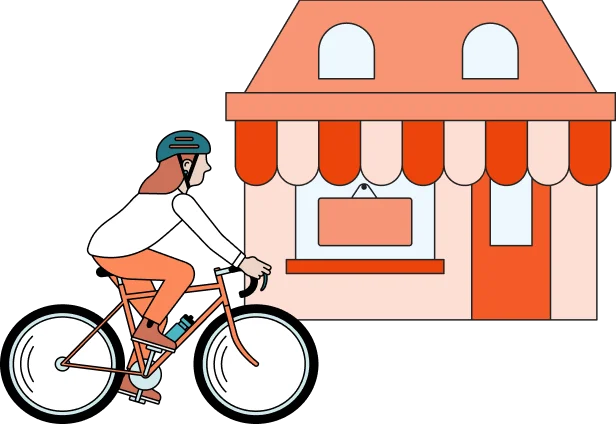Women-owned businesses are a central part of the economy. As of 2025, there are more than 14 million women-owned businesses in the United States, and new ones open each year. But there’s one unique challenge that women face when starting a business: getting access to capital and qualifying for small business loans.
Gender bias is a major concern in the lending industry, with women-owned businesses paying interest rates over 2 points higher than businesses owned by men.

Regardless of that bias, there are some things that women-owned businesses can do to increase their chances of getting the right loan through traditional lenders, as well as some extra opportunities they may take advantage of.
How do small business loans work in 2025?
Before we dive into the tactics that women-owned small businesses can use to get a loan that meets their business needs, it’s important to understand how small business loans work for both traditional and diverse businesses, even when the lending landscape is changing.
Simply put, small business loans are a type of financing backed by the Small Business Administration (SBA). The SBA doesn’t issue loans. Instead, they guarantee them, meaning if the business owner defaults on the loan, the SBA will pay the lender the remaining balance of the loan.
This makes it easier for small businesses to qualify for financing. Since someone else backs the loan, lenders are typically more willing to lend money to businesses that may not otherwise qualify. The loans they do offer may also have lower rates and better terms, helping small businesses grow without putting too much strain on their budgets.
SBA loans are only available to for-profit businesses. If you’re opening a nonprofit, you may need to look for a different type of financing.
2025 small business loan outlook
Policy changes can change the lending landscape, making it easier to qualify for loans in some years and harder in others. Currently, SBA loans are tougher to qualify for than they have been previously. This leaves many women-owned businesses having to explore alternatives like peer-to-peer loans, microloans, and grants that may offer smaller loan amounts.
How to get a small business loan in 6 steps
Every lender is free to set their own requirements and establish their own application process. However, most will follow the same general guidelines. Here are the steps you’ll need to take to apply for and get a small business loan.
- Figure out how much you need. Take a look at your budget and think about how much you need to borrow to bring your vision to life. This is the amount you’ll want to share with your lender.
- Gather the necessary information. You’ll need to provide lenders with a comprehensive business plan, personal and business financial statements, proof of insurance, and other similar documents. Gather these before you apply.
- Compare lenders. Look at the types of loans different lenders issue and the rates they tend to offer. This will help you figure out which lenders to apply with and which may not be the best fit for your needs.
- Submit applications. Once you have a list of lenders you want to work with, you’re ready to submit applications to your top choices. Try to apply with more than one lender if possible.
- Compare your offers. Once the lenders review your application and reach a decision, take the time to review their offers in detail. Look at the rates they’ll charge, origination fees, loan principal, and repayment terms.
- Close on the loan. Once you choose a loan, you can proceed to closing. During closing, you’ll sign all necessary documents with the lender. The lender will then transfer the money to you.
Building a business is enough work as it is. We'll help you start your LLC with confidence.

How are small business loans for women different?
Small business loans are functionally the same for both men and women. They’re designed to help business owners get the financing they need at rates and terms that are fair and competitive. However, since the lending market can be more challenging for women, finding lenders and resources that specialize in helping women business owners can make the process smoother.
These lenders and organizations understand the challenges that women face in business, not just in financing. They may examine applications more seriously and without the unconscious bias of traditional lenders.
The 5 best small business lenders for women
Lenders are supposed to assess each loan application on its own merits, regardless of the gender of the applicant. However, some loan officers may let their unconscious (or even conscious) biases get in the way of a fair review. Below are a few of the top lenders who have openly committed to helping women and business owners of all types get the financing they need.
1. Chase Bank
Chase Bank is an experienced SBA-approved lender and is widely known for its commitment to diversity and equality among its employees—and it carries this mission to help its customers. The bank offers a wide variety of small business financing options and business products that can help new and established entrepreneurs get the financing they need.
Chase offers the following types of business financing backed by the federal government:
- SBA 7(a) loans. Borrowers can take out loans of up to $5 million and can use the money to purchase a business, buy real estate, invest in equipment, and access working capital to grow their company or bring their business ownership dreams to life. The loans can also be used to pay for improvements or to help with cash flow.
- SBA 504 loans. Business owners can borrow up to 90% of the estimated cost of a project or the value of the collateral securing the loan. Depending on the loan, borrowers may have up to 25 years to repay the loan.
- SBA Express loans. Business owners can borrow up to $500,000 as a term loan or a business line of credit, depending on their needs and their financial situation. Rates are fixed or variable.
Business owners can visit local branches or speak with a loan officer online or by phone to learn more about the programs available or to start an application.
2. Huntington Bank
Huntington Bank is one of the biggest issuers of SBA loans, and the leaders of the SBA loan division are both women. Their loan officers openly express a commitment to fairly evaluate each application on its own merits, regardless of the gender or gender identity of the person applying for the loan.
In addition to the traditional SBA loans, Huntington also offers financing opportunities through their Lift Local program. This program focuses on providing new and stronger opportunities to veterans, women, and other underrepresented groups looking to start or grow their businesses by helping them access working capital.
3. Fora Financial
For female small business owners who need financing quickly and who are concerned about their ability to qualify for financing through the Small Business Administration loan program, Fora Financial may be a good alternative.
This lender offers online term loans that can be used for almost any business-related purpose, including real estate purchases, working capital, and equipment purchases. There are no collateral requirements for the loans, and their credit score requirements are lower than average. People need a minimum score of 570 to qualify.
That lower credit score requirement may help female entrepreneurs get the type of business financing they need without requiring a stable annual revenue for the business at the time of application.
4. Headway Capital
Headway Capital specializes in helping women entrepreneurs get business lines of credit for new ventures. They have flexible requirements for revenue and time in business, making it easier for newer companies to qualify. Credit limits are dependent on the applicant’s financial situation and the business’ projections and current profitability.
Because they specialize in helping women looking to open local businesses, Headway Capital may be a good fit for borrowers who have had trouble getting approval from other lenders.
5. Accion Opportunity Fund
Accion Opportunity Fund specializes in helping women, low-income business owners, and people of color get the financing they need. They offer small business term loans, truck financing for commercial vehicles, and food truck financing.
These loans are only available in 45 states. Businesses located in Montana, North Dakota, South Dakota, Tennessee, Vermont, and the District of Columbia do not qualify.
How to avoid predatory lenders
Predatory lenders are lenders that take advantage of borrowers through questionable practices. They may charge outrageous fees, offer higher interest rates, or set unreasonable repayment terms that make it difficult for borrowers to repay their loans on time.
Finding ways to avoid working with them in the first place can save borrowers money, time, and stress. Here are a few tips to help:
- Research lenders in detail. Read up on reviews to see what other borrowers have to say about each lender, and pay close attention to any experiences that other female small business owners have had with the lender. If others express concerns about their loans, their customer service, or their business practices, you may want to keep looking.
- Get quotes from several lenders. Comparing offers can help you figure out if one lender is charging predatory rates or fees. Read each offer in detail. If one quote has significantly higher rates or fees, or offers unreasonable repayment terms, it may be predatory.
- Watch out for high-pressure sales tactics. If a lender tries to pressure you into signing or sends blank forms that they promise to fill out after you sign, consider working with a different lender. By pressuring you into signing or sending blank forms, you could end up with a loan that you don’t understand, with terms that aren’t in your best interest.
- Use caution with unsolicited loan offers. When you start a business, you may get unsolicited offers from lenders. Some of these offers may be legitimate. However, others could be from predatory lenders looking to make a quick buck off of your new business. If you receive an unsolicited offer, proceed with caution. Review their terms in detail and only apply after doing your due diligence and researching the lender in detail.
- Explore alternatives. If loans feel out of reach, consider exploring different options. Depending on your situation, you may be able to qualify for a business line of credit, small business grant, or other similar financing alternative that better suits your financial situation.
Starting a business takes courage. LegalZoom makes sure the legal details don’t stand in your way, from the day you register until the day you retire.

How can LegalZoom help small businesses prepare for loan applications?
Lenders want to feel confident that women small business owners will be able to repay their loans in full by the end of the loan term. Having a strong financial position at the time of application can help, but lenders often want to see that the business they’re lending to is a more formal entity, not just an idea in a business owner’s mind.
This often requires taking steps to formalize the business before applying for financing. This may involve tasks such as the following:
- Establishing an LLC. Forming a limited liability company (LLC) establishes the business with the state and helps limit women business owners’ liability if anything goes wrong.
- Incorporating the business. Incorporating a business lets women small business owners fully separate themselves from the business by turning their company into a separate legal entity. This lets lenders do business directly with the company rather than the business owner and may instill more confidence in the application.
- Being in compliance. Some industries must meet certain requirements to be fully compliant with laws or regulations. When you’re starting out, figuring out the necessary regulations can be tough.
Business loan FAQs
What is the average amount of a small business loan in 2025?
According to a recent report by the Small Business Administration (SBA), the average small business loan amount in 2025 comes to $439,203. Keep in mind that every lender can set their own application requirements, and the amount you receive could be higher or lower than what you’re approved for.
What is the approval rate for small business loans?
The average approval rate for small business loans tends to hover around 50%. That’s why it’s important to set your application up for success, especially for women business owners who may be unfairly assessed on the basis of their gender.
LegalZoom’s business formation services may be able to help increase your chances of being approved for a loan by helping you set your business up in a way that inspires confidence in your company.
What credit score do you need to get a small business loan?
Lenders set their own requirements. However, many expect small business owners to have credit scores of around 690. That said, the higher your credit score is, the more favorably lenders will typically view your application, as higher credit scores can indicate that the borrower is more responsible and more likely to repay the loan once they take it out.
Can you get business financing with a low credit score?
Having a low credit score may not mean that women-owned businesses won’t qualify for some type of small business funding. You just may need to look into alternatives like revolving credit, grants, and other programs, either through your local community, women’s business organizations, or through federal agencies.
Are there women-specific small business loans?
No, there are no SBA loan programs specifically designed for female small business owners. However, there are lenders who are more willing to work with women entrepreneurs than others. That said, lenders are supposed to base their decisions on the individual’s loan applications rather than their gender.
If a loan officer seems more focused on your gender than the strength of your application, you may want to keep looking.


